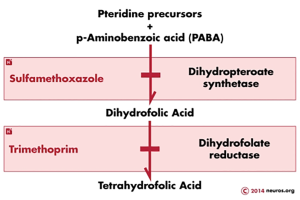| Structure/Class |
- Trimethoprim is an inhibitor of dihydrofolate reductase
|
| Pharmacodynamics |

- Trimethoprim is a bacteriostatic drug, but it is used synergistically with sulfonamides because they inhibit sequential steps in DNA synthesis. This combination then becomes bactericidal.
- Indications as follows:
- Oral trimethoprim – treat UTI
- Bactrim has a broad spectrum of uses: PCP pneumonia, bacterial diarrhea (treat salmonella and shigella) and UTI/prostatitis.
- IV Bactrim is used to treat severe PCP pneumonia.
- Pyremethamine/sulfonamides used to treat leishmaniasis/toxoplasmosis
- Resistance is plasmid encoded, and due to:
- Reduced cell permeability
- Altered binding sites
- Overproduction of dihydrofolate reductase
|
| Absorption/administration |
- PO and IV
|
| Distribution |
- Well absorbed and distributes to all body tissue, including the CNS.
|
| Metabolism |
|
| Excretion |
- By renal mechanisms
- Dose needs to be reduced in renal impairment.
- It is a weak base, and therefore tends to concentrate in urine (which is a weak acid). This property increases its activity in prostatic and vaginal fluids.
|
| Adverse events |
- Anaemia, leukopenia and granulocytopaenia (same with other anti-folate drugs)
- Also has other idiosyncratic reactions – N/V, vasculitis and renal damage.
|
| Dosing/administration |
|
| Toxicology |
|
| Withdrawal syndrome |
|
| Special notes |
|